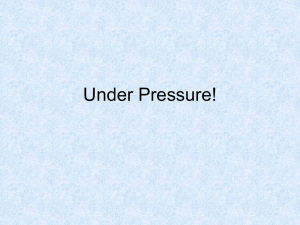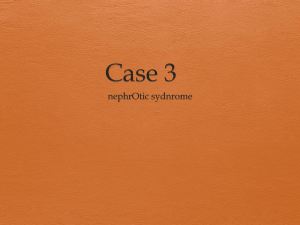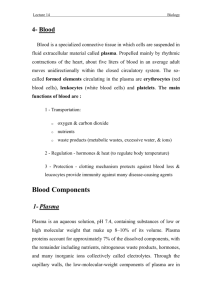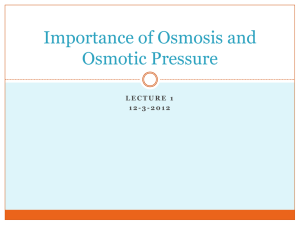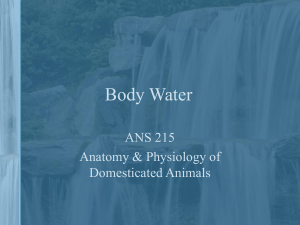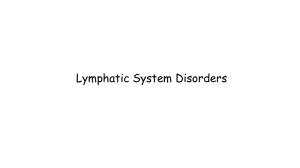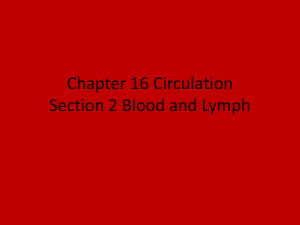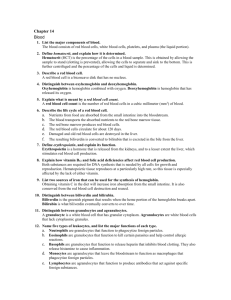Chapter 7 Blood
advertisement
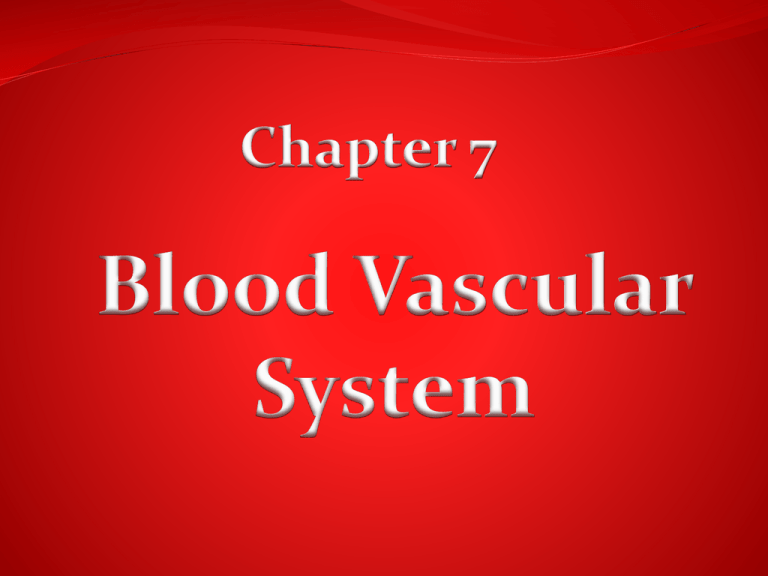
Blood Vascular System Made up of 4 Parts: Blood – a fluid connective tissue that transports oxygen and nutrients around the body and collects waste products produced by the tissues 2. The Heart – a hollow, muscular, four-chambered organ responsible for pumping blood around the body 3. The Circulatory System – a network of arteries, veins, and capillaries in which the blood flows around the body 4. They Lymphatic System – a network of lymphatic vessels that transports lymph or excess tissue fluid around the body and is responsible for returning it to the circulation Consists of several types of cell suspending in a liquid medium called Plasma. It makes up for 7% of the total body weight and has a pH of about 7.4 1. Blood Functions: Transport Gases in solution – blood carries oxygenated blood from the lungs and delivers the oxygen to the tissues where it used. It then collects deoxygenated blood containing carbon dioxide produced by the tissues during their metabolic processes, and carries it back to the lungs, where the carbon dioxide is exchanged for oxygen in the inspired air. Nutrients – blood transports nutrients, e.g. amino acids, fatty acids and glucose, which result from the process of digestion, from the digestive system to the liver and to the tissues where they are needed. Waste Products – blood collects the waste products resulting from metabolism in the tissues and transports them to the kidney and liver where they are excreted from the body. Hormones and Enzymes – blood transports enzymes and hormones from the endocrine glands to their target tissues Blood Functions: Regulation Blood plays a vital role in homeostasis by regulating: Volume and constituents of the body fluids – blood carries water in the form of plasma to the tissues and is responsible for maintaining the osmotic balance of the fluids and the cells. The presence of plasma proteins, particularly albumin in the blood, controls the flow of fluid between the fluid compartments and is responsible for maintaining blood volume and blood pressure. Body Temperature – blood conducts heat around the body to the body surface where if necessary it is lost by peripheral vasodilation. Acid-base balance – blood maintains a constant internal pH in the body by the presence of buffers, e.g. bicarbonate, which are able o absorb H+ ions when the blood is acid and give out H+ ions when the blood is alkaline. In his way, all he processes of the body are able to function effectively. Defense against infection – blood helps to prevent infection through the action of the white blood cells, which are part of the body’s immune system. It also carries antibodies and antitoxins produced by the immune system around the body. Blood Clotting – the clotting mechanism prevents excessive blood loss from wounds and other injuries and prevents the entry of infection. Blood Functions: Problems with Oedema Oedema is an abnormal accumulation of fluid in the cavities and intercellular spaces of the body. When oedematous fluid accumulates in the peritoneal cavity it is described as ascites. Oedema occurs when there is an imbalance between osmotic pressure and hydrostatic pressure. It can be caused by a number of factors, e.g. anything that increases osmotic pressure outside the blood vessels, such as inflammation , or reduces osmotic pressure in the blood, such as hypoproteinaemia. Increased hydrostatic pressure inside blood vessels resulting from heart failure may also cause oedema. Composition of Blood Blood is a red fluid that is carried by the blood vessels of the circulatory system. It is composed of a fluid part, the plasma, and a solid part, the blood cells. Plasma forms part of extracellular fluid. Each constituent of the blood plays a specific part in the overall function of blood. Composition of Blood: Plasma Plasma is the liquid part of the blood that separates out when a blood sample is spun in a centrifuge The main constituent is water (about 90%) in which are a number of dissolved substances being transported from one part of the body to another These include carbon dioxide in solution, nutrients such as amino acids, glucose and fatty acids, waste materials such as urea, hormones, enzymes, antibodies and antigens. Composition of Blood: Plasma Contents Plasma contains: Mineral Salts – the main mineral salts found in extracellular fluid are sodium and chloride, but potassium, calcium, magnesium, and bicarbonate are also present. The functions of these mineral salts include maintaining osmotic balance and maintaining pH by acting as buffers. Calcium has a number of essential roles in the body, e.g. in blood clotting, muscle contraction and nerve function. Plasma Proteins – these help to maintain the osmotic pressure of the blood because they are too large to pass out of the circulation. This has the effect of retaining fluid in the blood by osmosis, i.e. it prevents too much water from ‘leaking’ out into the extracellular spaces. If this did occur then the volume of the blood would decrease and the blood pressure would fall with serious consequences. The most important Proteins are: Albumin: helps to maintain the osmotic concentration of blood, i.e. holds the water in the blood Fibrinogen and Prothrombin: involved in the clotting mechanism of the blood Immunoglobulin's: these are the antibodies produced by the immune system of the body Albumin, Fibrinogen and Prothrombin are produced by the liver, but the immunoglobulin’s are produced by the cells of the immune system Composition of Blood: Blood Cells The blood cells make up the solid component of blood and can be divided into three types: Erythrocytes – the red blood cells Leucocytes – the white blood cells Thrombocytes – the platelets, which are cell fragments Terms to understand: Haemopoiesis – the formation of all types of blood cell Erythropoiesis – the formation of red blood cells or erythrocytes Lymphoid tissue – found in the lymph nodes and spleen and produces agranular leucocytes, i.e. lymphocytes and monocytes Myeloid tissue – found in the red bone marrow and responsible for the formation of erythrocytes and granular leucocytes, i.e. neutrophils eosinophils and basophils Serum – plasma minus the clotting factors fibrinogen and Prothrombin. It can be obtained by allowing a blood sample to clot naturally. Composition of Blood: Erythrocytes (Red blood cells) Erythrocytes are the most numerous blood cell – there are about 6-8 million per cubic millitre of blood. Their function is to transport oxygen and a small proportion of carbon dioxide around the body (most carbon dioxide is carried in solution in the plasma). Mature erythrocytes are biconcave circular discs about 7

